Introduction
In today's competitive online marketplace, optimizing your e-commerce site is crucial for driving sales and staying ahead of the game. However, it's not just about enhancing aesthetics; it's about refining functionality and user experience. By implementing a comprehensive approach to e-commerce optimization, you can significantly boost your conversion rates and increase sales without pouring more money into your marketing budget.
Building a robust infrastructure is key to modernizing and scaling your e-commerce operations. This means ensuring top-notch servers, firewalls, and encryption, as well as leveraging cloud hosting for scalability. Embracing serverless architecture for core functions like order processing and inventory management can also revolutionize your e-commerce platform, making it more agile and cost-efficient.
To stay competitive, you need to adopt new, effective strategies. Artificial Intelligence is revolutionizing the e-commerce landscape by personalizing the shopping experience, making it more relevant to each individual customer. By implementing these optimization strategies, you're not only improving the shopping experience, but also setting the stage for future growth and success.
In this article, we will explore the key elements of e-commerce optimization, understand user behavior, enhance website performance, streamline the checkout process, optimize product pages, leverage personalization, prioritize mobile optimization, harness the power of SEO, utilize A/B testing and analytics, and discuss the benefits of e-commerce optimization services. We will also guide you in choosing the right e-commerce optimization services provider. So, let's dive in and discover how you can create an unparalleled shopping experience for your customers.
Why Ecommerce Optimization Matters
Improving your e-commerce site goes beyond enhancing aesthetics; it's a comprehensive approach to refining the functionality and usability of your online store. A well-optimized e-commerce platform can significantly boost your conversion rates. For instance, if you're currently seeing 100 conversions from 5,000 visitors, your conversion rate stands at 2%. Imagine increasing that figure by just 1 or 2 percent—it could translate to a substantial uplift in sales without pouring more money into your marketing budget.
Building a robust infrastructure is the cornerstone of modernizing and scaling your e-commerce operations. This means not only ensuring that your servers, firewalls, and encryption are top-notch but also leveraging cloud hosting for scalability. Consider AWS for creating an infrastructure that can grow with your business, freeing you from the limitations of traditional hardware and software maintenance.
Embracing serverless architecture for core functions like order processing and inventory management can revolutionize your e-commerce platform by making it more agile and cost-efficient. With serverless, you're only paying for the actual compute time you consume, which can be a game-changer for managing costs and scaling operations.
The trends shaping e-commerce are constantly evolving, and staying ahead means adopting new, effective strategies. Artificial Intelligence, for instance, is transforming the e-commerce scenery by customizing the shopping journey, making it more pertinent to every individual shopper. As you implement these optimization strategies, you're not just improving the shopping experience—you're also setting the stage for future growth and success in an increasingly competitive online marketplace.
Key Elements of Ecommerce Optimization
Thriving in the online business domain necessitates a profound comprehension of enhancement techniques that elevate the user experience and improve website functionality. Gothrider Coffee's founder, Phil Kyprianou, exemplifies this through his strategic use of product bundling to differentiate his brand. This tactic not only adds value for customers but also addresses the need for operational efficiency, a common challenge for Shopify store owners.
Similarly, Filson's collaboration with Bamboo's growth insights service to develop a customizable forecasting model showcases the importance of accurate sales predictions for online retail success. Their model's impressive prediction accuracy, including a forecast within 0.4% of actual sales for one month, underlines the significance of leveraging data to anticipate online commercial trends and performance.
The combination of online and offline shopping, known as 'phygital', is also transforming ecommerce. According to Keith Kirkpatrick from The Futurum Group, the ease and promptness of this mixed method prioritize the requirements of clients, a feeling echoed by the flawless encounters desired by today's consumers.
To stay competitive, retailers must adapt to emerging trends and technologies, including the use of artificial intelligence to personalize shopping experiences. An insightful digital presence is crucial, as the average shopper begins their journey online, comparing products and seeking information before making a purchase. This emphasizes the need for well-optimized product listings and content that addresses consumer inquiries early in the buying cycle.
In this dynamic environment, striking a chord with your audience through compelling content and resonating headlines is key. Folia's headline demonstrates the power of engaging with individuals by tapping into their needs and values. Ensuring your website's functionality aligns with these principles is vital for engaging clients and driving conversions.
Therefore, the key elements of a thriving online store extend beyond just aesthetics; they include a strategic combination of brand distinctiveness, operational effectiveness, precise forecasting, a 'phygital' presence, and compelling content—all aimed at crafting an unparalleled shopping experience for shoppers.
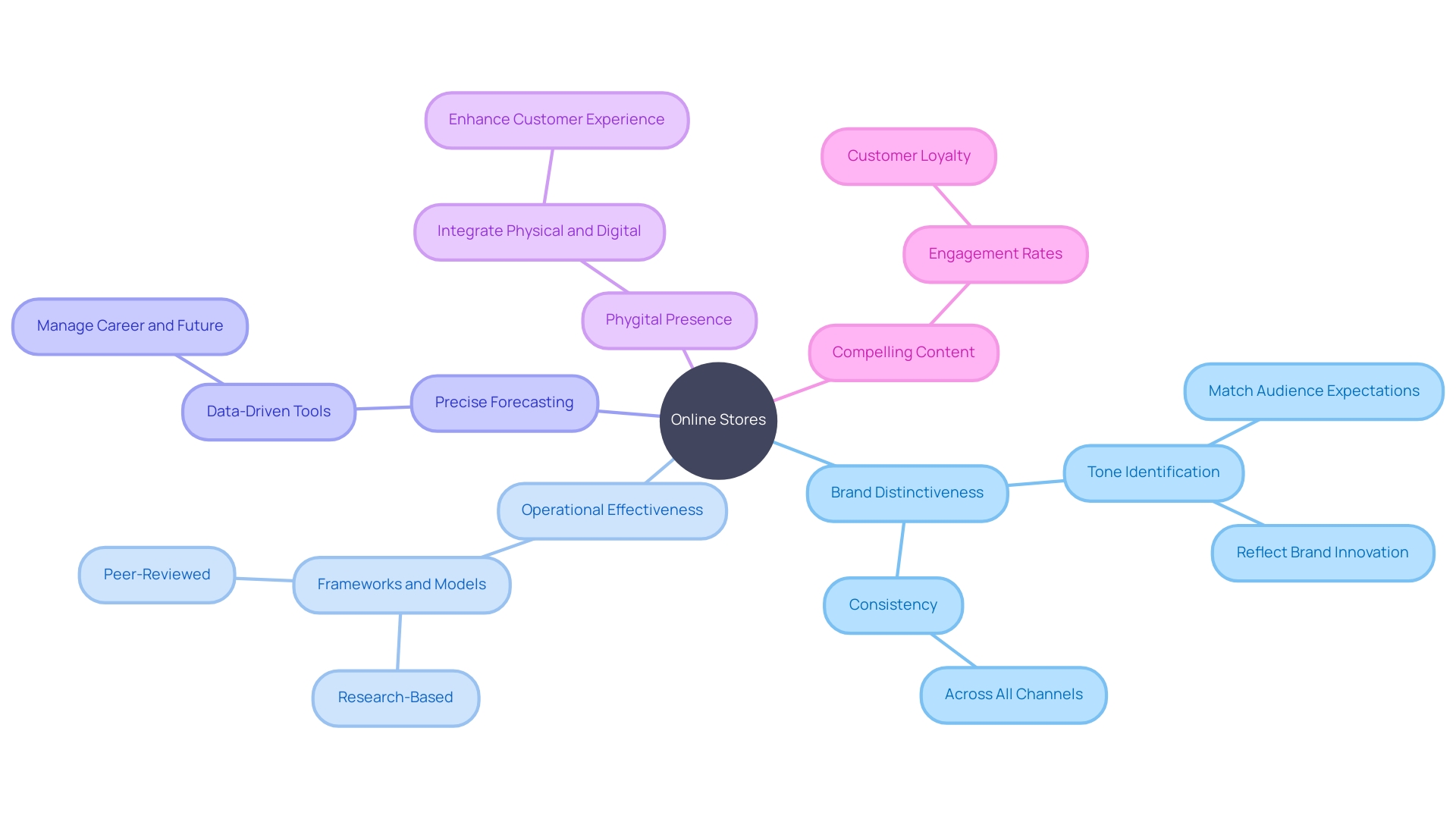
Understanding User Behavior
To effectively optimize your e-commerce presence, a thorough understanding of customer behavior is essential. This involves more than just skimming through analytics; it's about delving into data to uncover the nuanced ways individuals interact with your site. We'll explore techniques and resources that can identify patterns of individuals, such as how seeking reassurance affects conversion rates. For instance, when FedEx offered volume discounts to individual parcel shippers, it highlighted the importance of transparent pricing—a lesson echoed by Wise's success in the international payments arena. Additionally, the significance of immediate confirmation post-transaction, similar to instantly seeing an Airbnb booking, cannot be understated as it alleviates customer anxiety and contributes to the overall satisfaction of individuals.
'Artificial Intelligence (AI) is revolutionizing this analysis, personalizing shopping experiences by predicting individual behavior and adapting in real-time.'. This engagement leads to retention and growth, as evidenced by Sequoia's framework. It's about understanding both frequency and the context of interactions with your product. Oxford Comma Digital's insights on adapting strategies during economic shifts emphasize the value of proprietary data to capture these behavioral nuances. Measuring behavior through goals, as emphasized by the founder of Oxford Comma Digital, helps businesses align their online platforms with overarching business objectives, be it through purchase transactions or feature utilization.
This thorough approach to understanding individual behavior is supported by statistics showing the expansion of e-commerce across various markets, from beverages to consumer electronics, emphasizing the industry's capacity to innovate and reach global audiences. By embracing these insights and trends, you'll be well-equipped to refine your e-commerce strategy, ensuring it resonates with individuals and drives success in a dynamic marketplace.
Enhancing Website Performance
Optimizing e-commerce websites for peak performance is not just about aesthetics; it's about the bottom line. The speed at which a website loads is an important aspect, as a mere one-second delay could result in businesses losing a massive £28.4 billion in sales, based on information from Fasthosts and the Adobe Digital Economy Index. The need for velocity is emphasized by the reality that more than half of internet traffic currently originates from mobile devices, where users anticipate rapid and effective browsing encounters.
Achieving a swift website requires a multifaceted approach. Image optimization is one key area; reducing file sizes without compromising quality ensures visuals load rapidly and maintain the site's visual appeal. Implementing caching is another effective strategy. By storing copies of files, caching allows for faster access to data and reduces server lag.
Performance measurement is an indispensable first step, providing a benchmark to gauge the effectiveness of optimization efforts. Tools like Google's PageSpeed Insights yield actionable insights, making it possible to pinpoint areas that need improvement.
Keep in mind, a superior mobile encounter is not only user-friendly—it's also a determinant of business success. Statistics show that mobile-friendly sites see a 74% likelihood of return visits and a 67% higher probability of a purchase. With conversion rates climbing by 15% for sites that load in two seconds or less, the message is clear: speed and reliability are not just website enhancements, they are essential components for thriving in today's digital marketplace.
Streamlining the Checkout Process
Optimizing the checkout procedure is crucial for improving the overall satisfaction and increasing the rate of successful transactions. To curb the high cart abandonment rates, simplifying form fields is key. A cluttered checkout can deter customers, but a clean, straightforward form increases the likelihood of a successful transaction. Guest checkout options are another effective strategy to expedite the checkout experience. This convenience eliminates the barrier of account creation, which is often a point of friction for new users.
Secure payment gateway integration is non-negotiable in today's ecommerce environment. With security concerns at an all-time high, providing a secure and reliable payment process can be the deciding factor for customers contemplating a purchase. Incorporating AI and machine learning, similar to the computer vision object recognition used by BigBasket, can further refine the checkout process by swiftly adapting to new products and SKUs, ensuring a seamless and up-to-date user experience.
Moreover, cutting-edge checkout technologies, similar to those used by the Dublin Town To Go store, provide glimpses into the future of online business. Their use of Zippin technology, which combines cameras and weight-sensor shelving to detect purchases and charge individuals automatically, is revolutionizing the way we think about checkouts.
By adopting these best practices and staying updated on the latest ecommerce trends and technologies, businesses can develop a checkout process that not only fulfills but surpasses customer expectations, resulting in enhanced loyalty and continuous growth in the competitive online marketplace.
Optimizing Product Pages
Optimizing product pages goes beyond mere functionality; it's about creating a captivating and converting atmosphere. Whether showcasing tangible items, digital goods, or an array of services, the goal remains the same: to make your offerings irresistible. A product page is more than a simple transaction point; it's a virtual stage where your product stars in its best light. To achieve this, compelling copy, striking visuals, and persuasive calls-to-action are indispensable. Like the vital ingredients in a recipe, each element must be carefully measured and artfully combined to ensure your product pages are as tempting as freshly baked delicacies. Statistics show that even subtle nuances in presentation can significantly influence conversion rates. For instance, accurately calculating conversion rates requires a keen eye for detail, ensuring that you're making like-for-like comparisons to avoid data misinterpretation that could derail your optimization efforts. Moreover, incorporating user-generated content and reviews into your product pages does more than build trust; it provides a multi-faceted view that resonates with potential buyers. The addition of particular, relatable details can make all the distinction, converting browsers into buyers and enhancing the overall shopping process. By embracing these proven techniques, you elevate your ecommerce platform from a simple marketplace to an influential and engaging destination that consistently drives sales.
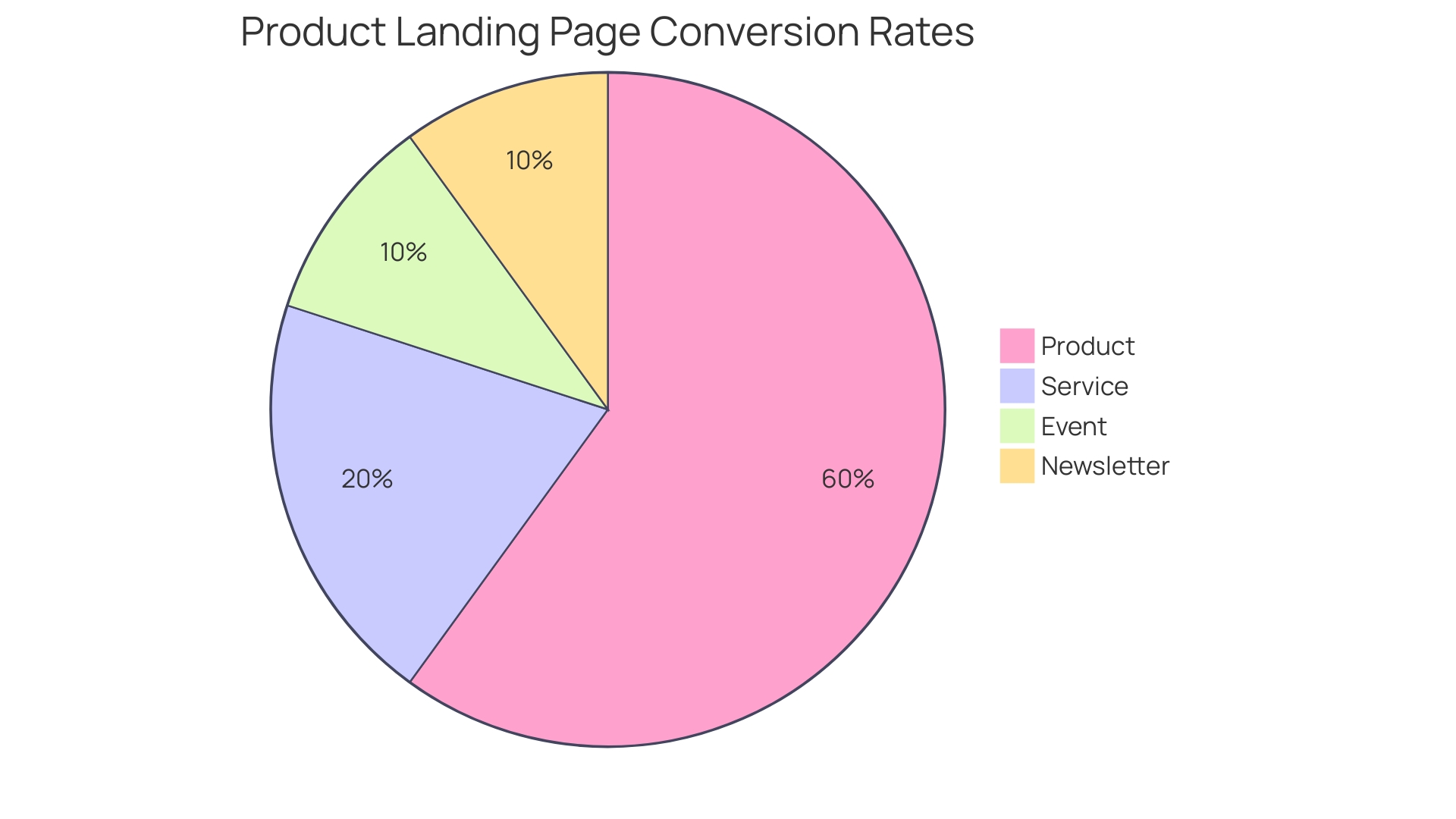
Leveraging Personalization
Delving into the realm of personalization, it's evident that the art of creating tailored shopping experiences is not just a trend but a core strategy for contemporary e-commerce success. Using user data and preferences, e-commerce platforms can create personalized product recommendations, targeted promotions, and content that resonates with each individual shopper. Operator-generated collections, for example, are manually curated selections that often highlight popular or seasonal items, providing a bespoke touch to the shopping journey.
A testament to personalization's efficacy is the case of Filson, which collaborated with Bamboo's growth insights service to develop a customizable forecasting model. This model, with inputs adjustable for variables such as buyer lifetime value and acquisition cost, forecasted their e-commerce sales with impressive accuracy, hitting the nail on the head at 99.6% for one month's prediction during the holiday season.
In the backdrop of digital disruption, AI and machine learning are game changers, enabling brands to sift through consumer data and offer finely-tuned content. This level of customization not only enhances the consumer's role in product design but also fosters a connection that's as personal as the barista knowing your coffee order before you place it. It's this close understanding and attention to detail that sets businesses apart and fosters loyalty.
In fact, 71% of clients now anticipate a tailored encounter each time they engage with a brand, with 76% feeling annoyed when it's missing. The benefits are clear: 91% of consumers show a preference for brands that remember their preferences and provide relevant offers. This change towards personalization requires a thorough comprehension of the client, a dedication to gathering data, and a commitment to promoting a client-focused culture. Every decision and interaction should aim to improve the customer journey, making it not just a transaction but a distinctive and unforgettable encounter.
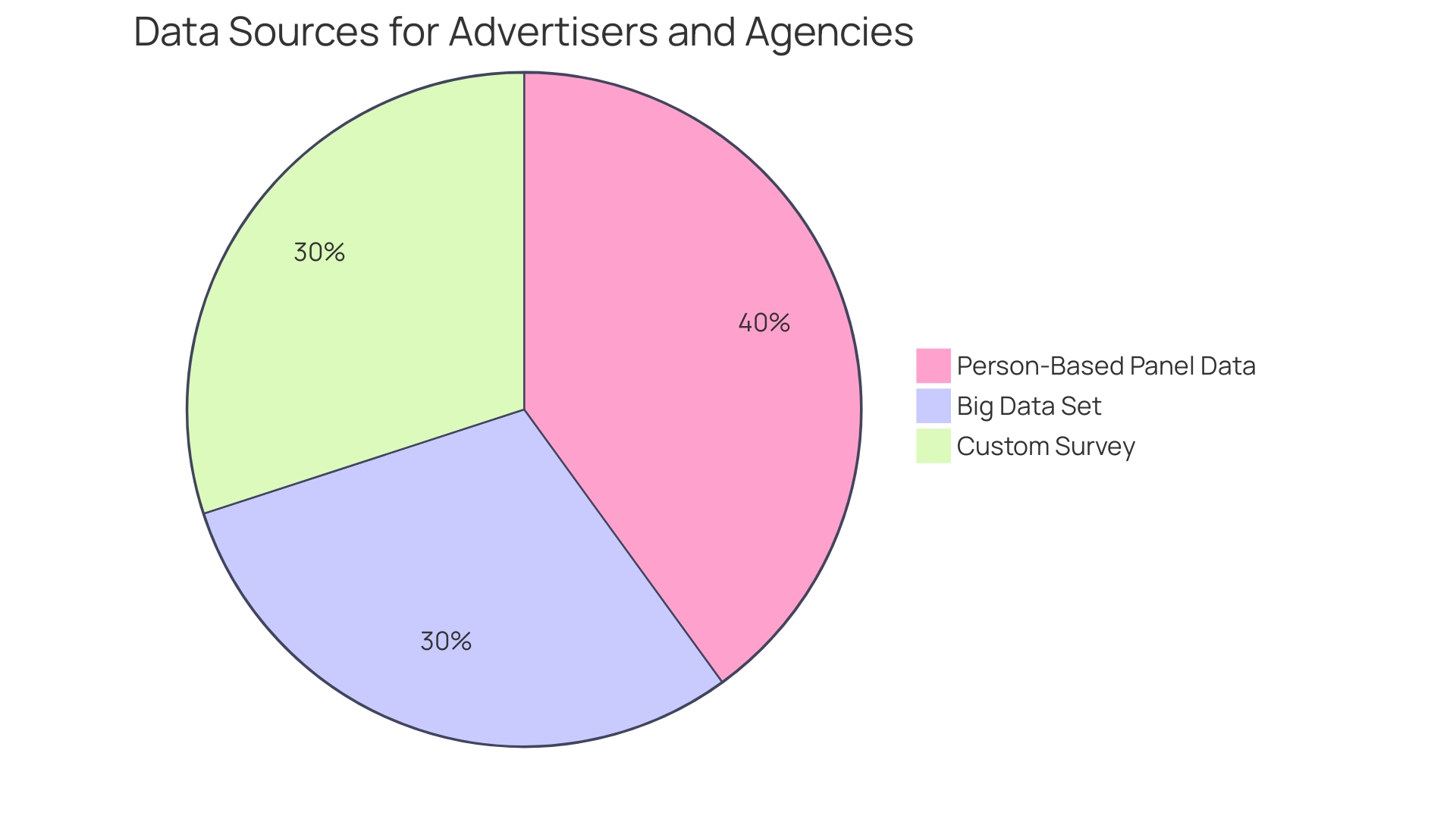
Importance of Mobile Optimization
The shift towards mobile commerce is undeniable, with an ever-increasing number of consumers browsing and buying via their smartphones. This reality requires a strategy that prioritizes mobile devices, which involves designing digital content with the needs of mobile users in mind. Such an approach is not just about scaling down a website to fit a smaller screen, but rather about rethinking the user experience to ensure it's intuitive and accessible on mobile devices. The surge in mobile usage has fundamentally altered web design, emphasizing the need for streamlined, user-friendly interfaces across all platforms.
Optimizing for mobile is not a mere suggestion, it is a necessity. Comprehending when, where, and how consumers engage with brands is crucial for crafting a full-funnel strategy that resonates with your target audience. According to comScore's State of Digital Commerce report for 2024, understanding the consumer journey across multiple platforms is integral to success in today's digital marketplace.
Moreover, with generative AI's potential to enhance customer service by improving brand knowledge and customer memory, retailers like Colgate-Palmolive are harnessing its power for creating accurate and optimized product descriptions. This technology is a game-changer, providing a significant edge in the fiercely competitive ecommerce landscape.
As outlined by industry experts, a mobile-first strategy centers on the constraints and opportunities of mobile platforms. It's about crafting an optimal experience for individuals on smaller screens, which often leads to a more instinctive and reachable design. This ensures that the essential features and content are easily accessible, often leading to improved satisfaction and engagement of individuals.
Beyond design, performance is equally critical. A journey to improve app performance, as undertaken by Shopify for its mobile application serving millions of merchants, underscores the importance of setting strategic goals to enhance speed and responsiveness. A website that loads quickly is crucial as it directly affects the individual's impression of your business and their likelihood to convert into a customer.
In essence, mobile optimization is about connecting users quickly and seamlessly to what they're looking for, which in turn, influences their perception of your brand. The mobile offering you provide can expand your reach and greatly enhance conversions, making it an essential component of online business success.
Role of SEO in Ecommerce Optimization
Improving your online retail website for search engines is more than just a recommended action—it is essential in the digital market where the majority of online interactions, approximately 93%, initiate with a search engine. An efficient SEO plan for ecommerce not only enhances your visibility but also improves user satisfaction, aiding shoppers in finding the information they need to make informed purchases. Cultivating trust and authority becomes paramount as it directly influences traffic and revenue by aligning with the right search intent.
Enhancing product pages and site structure is key. Including customer reviews and user-generated content on these pages not only establishes credibility but also enhances the content with keywords that prospective customers utilize in their search queries. This approach aligns with Google's evolving search algorithms which, as recently noted by Google's Head of Search, Liz Reid, aim to provide quick answers and the ability to dive deeper into web content. With the implementation of SGE (Search Google Engine) summaries, the emphasis is moving towards AI-driven snapshots that offer extensive information and direct individuals to pertinent sources.
To guarantee your online store stands out in this competitive landscape, it's crucial to conduct thorough keyword research. This involves identifying high search volume keywords with low ranking difficulty and high purchase intent. It's a meticulous process, but with the right tools—be it free or premium keyword planners—you can pinpoint the queries your target audience is using and optimize your content accordingly.
Bear in mind, attaining a high position for a keyword is not only about completing SEO best practices; it's about comprehending and fulfilling the requirements of your audience. As per our software's analysis of over 100 million domains, the 42,391 sites actively improving their SEO saw a noticeable increase in traffic. And with the findings of a recent meta-analysis on click-through rates within Google Search, it's clear that where you invest your marketing efforts can significantly impact your online success. By prioritizing the experience of individuals, aligning with the intentions of search, and utilizing the most recent advancements in search engines, your online shopping platform can attract the attention and loyalty of internet shoppers.
Utilizing A/B Testing and Analytics
Harnessing the power of A/B testing and analytics can be transformative for your ecommerce website. Diving into the world of A/B split testing empowers you to compare two website versions to determine which one resonates best with your audience, whether it's to improve click-through rates or to boost sales. Through careful testing and analysis of individual behavior, you are prepared to make informed, data-driven decisions to optimize your site's performance.
To initiate an effective A/B test, it's crucial to craft a clear, concise problem statement that identifies your current situation, the desired outcome, and the obstacle that lies in between. This problem statement will not only guide the design of your experiment but also ensure alignment among stakeholders and serve as a benchmark to measure success. A/B testing is not a one-size-fits-all approach; it must be tailored to the specific industry and unique challenges of the business.
For example, Shake Shack employed Qualtrics AI to discover crucial insights and enhance their marketing approach, emphasizing the significance of effective communication to individuals when introducing fresh ideas. Similarly, by leveraging Amplitude Analytics, product teams have gained valuable insights into user behavior, leading to more effective product design and presentation online.
Furthermore, Keith Kirkpatrick from The Futurum Group highlights the fusion of physical and digital encounters, emphasizing the significance of being 'phygital' in the current marketplace by giving priority to customer convenience and efficiency. This underscores the significance of A/B testing in optimizing not just the online experience but also the integration of online and offline channels.
In analyzing results, calculating conversion rates is straightforward yet requires precision to avoid skewed data. By focusing on specific visitor segments and timeframes, you can more accurately gauge the impact of the changes you test.
As a method rooted in statistical power and sensitivity, A/B testing goes beyond mere comparison, serving as the foundation for strategic decision-making. Remember that best practices from industry giants may not translate directly to all businesses. By understanding the nuances and adapting strategies to your own context, you can avoid the pitfalls of generic approaches and realize the full potential of A/B testing for your ecommerce site.
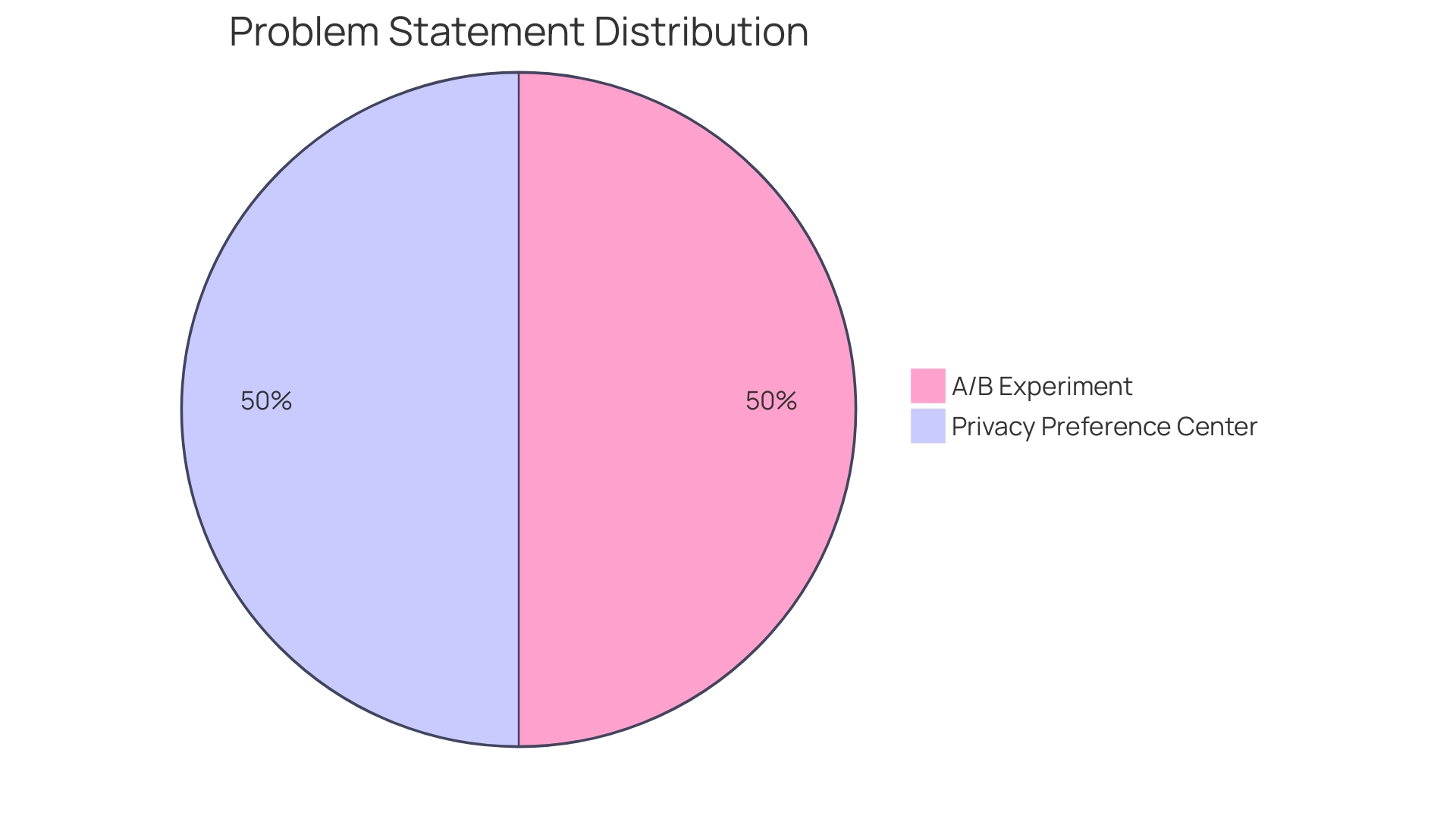
Benefits of Ecommerce Optimization Services
Optimizing an e-commerce platform can sometimes feel like navigating through a complex digital landscape. However, just as Lemonaid Health discovered when they faced the challenge of managing a diverse range of telehealth services with varying customer acquisition costs, the solution often lies in harnessing the power of specialized expertise. By engaging with e-commerce optimization services, businesses can tap into a wellspring of knowledge, advanced tools, and technologies that streamline the process. A compelling example of the efficacy of this approach is Bamboo's collaboration with Filson, where they developed a customizable forecasting model that predicted e-commerce sales with staggering accuracy—one month's forecast came within 0.4% of actual sales. This level of precision is not just impressive; it's invaluable for businesses looking to invest wisely and maximize their online potential.
The digital marketplace is crowded, as evidenced by the over 2.14 billion global online shoppers—a number that's been steadily rising since 2016. In such a competitive space, it's not enough to simply exist online. Retailers must craft an online presence that is not just visually appealing but also optimized for conversion. The formula for calculating conversion rates might be simple, but the execution is far from it. It requires a nuanced understanding of visitors' interactions with specific pages and products. As the retail landscape evolves, the importance of delivering a seamless and informative digital experience becomes paramount. Retailers must now focus on creating content that not only stands out in search engine results but also provides the information consumers seek at the beginning of their buying journey.
Incorporating these insights into your e-commerce strategy could be the key to unlocking your platform's full potential. It's not just about having an online presence; it's about making that presence count by leveraging the expertise of optimization services to create a digital storefront that captivates and converts.
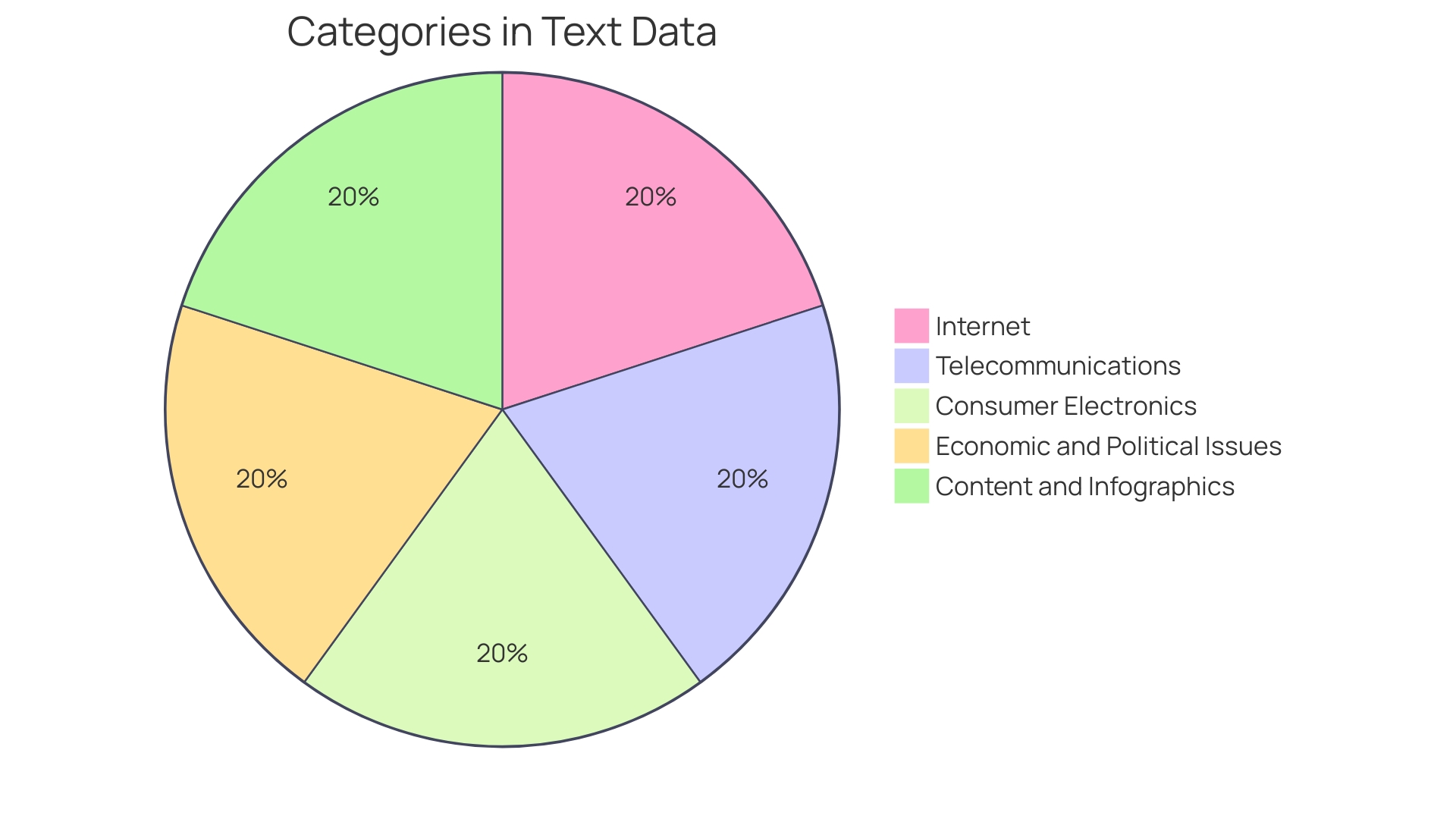
Choosing the Right Ecommerce Optimization Services Provider
Choosing the suitable optimization services provider is a crucial decision that directly affects the performance and scalability of your online presence. It's essential to choose a vendor who not only offers competitive pricing and a suite of services but also brings a proven track record to the table.
A trustworthy provider should be able to build a strong infrastructure, which is the foundation of a contemporary, thriving online business. Robust infrastructure refers to the integration of reliable technology, powerful servers, advanced firewalls, and secure encryption tools. In an era where over 2.14 billion people are expected to make online purchases, according to Statista, the stakes are high for online shopping platforms to deliver seamless customer experiences.
The structure of your online business solution should facilitate scalability, allowing you to adapt to the growing demands of the digital market. Consider if the provider leverages cloud hosting solutions like AWS to ensure scalability and ease of management. In addition, assess if they support serverless architecture for essential functions like order processing and inventory management, which are the foundation of online business operations.
Furthermore, comprehending the conversion rate is a crucial aspect of online business optimization. A sound provider will assist you in accurately calculating and enhancing your conversion rates, which are crucial metrics for evaluating the vitality of your online business. With the online shopping industry witnessing remarkable growth, as evidenced by the success stories of Amazon's Great Indian Festival and the entrepreneurial triumphs on Flipkart's platform, it's evident that innovation and optimization are key drivers of success.
In summary, when choosing an ecommerce optimization services provider, it is paramount to assess their ability to build and maintain a scalable infrastructure, their experience in optimizing conversion rates, and their commitment to staying abreast of the latest trends and technologies in ecommerce. By partnering with a provider that fulfills these criteria, you can position your online business for enduring growth and success.
Conclusion
In today's competitive online marketplace, optimizing your e-commerce site is crucial for driving sales and staying ahead. By implementing a comprehensive approach to e-commerce optimization, you can boost conversion rates and increase sales without pouring more money into your marketing budget.
Building a robust infrastructure with top-notch servers, firewalls, and encryption is key. Embracing serverless architecture and leveraging cloud hosting for scalability can revolutionize your e-commerce platform, making it more agile and cost-efficient.
Artificial Intelligence is revolutionizing the e-commerce landscape by personalizing the shopping experience. Understanding user behavior through data analysis and AI predictions allows for better engagement and growth.
Enhancing website performance, such as optimizing loading times and utilizing image optimization and caching, is crucial for meeting customer expectations and driving conversions. Streamlining the checkout process with simplified forms and secure payment gateways can boost the customer experience and increase sales.
Optimizing product pages with compelling copy, striking visuals, and user-generated content builds trust and drives conversions. Personalization, using customer data to craft tailored recommendations and content, fosters a deeper connection and cultivates loyalty.
Mobile optimization is essential in today's mobile-first world. Designing for mobile users, optimizing for speed and performance, and adopting a mobile-first strategy can significantly increase conversions.
SEO plays a vital role in e-commerce optimization. Thorough keyword research and aligning with search intent are crucial for visibility and improved user experience.
Harnessing the power of A/B testing and analytics enables data-driven decisions to optimize performance. Comparing website versions and analyzing user behavior leads to informed improvements.
Engaging with e-commerce optimization services streamlines the process and taps into advanced tools and expertise. Choosing a provider with a proven track record, robust infrastructure, and expertise in optimizing conversion rates is essential for success.
By implementing these strategies and partnering with the right provider, you can position your online business for enduring growth and success in the competitive online marketplace.





